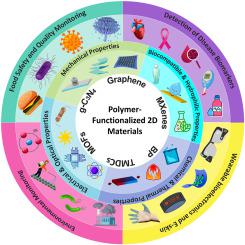当前位置:
X-MOL 学术
›
Anal. Chim. Acta
›
论文详情
Our official English website, www.x-mol.net, welcomes your feedback! (Note: you will need to create a separate account there.)
A review of biocompatible polymer-functionalized two-dimensional materials: Emerging contenders for biosensors and bioelectronics applications
Analytica Chimica Acta ( IF 5.7 ) Pub Date : 2024-06-18 , DOI: 10.1016/j.aca.2024.342880 Tahreem Zahra , Umme Javeria , Hasan Jamal , Mirza Mahmood Baig , Farid Akhtar , Urooj Kamran
Analytica Chimica Acta ( IF 5.7 ) Pub Date : 2024-06-18 , DOI: 10.1016/j.aca.2024.342880 Tahreem Zahra , Umme Javeria , Hasan Jamal , Mirza Mahmood Baig , Farid Akhtar , Urooj Kamran

|
Bioelectronics, a field pivotal in monitoring and stimulating biological processes, demands innovative nanomaterials as detection platforms. Two-dimensional (2D) materials, with their thin structures and exceptional physicochemical properties, have emerged as critical substances in this research. However, these materials face challenges in biomedical applications due to issues related to their biological compatibility, adaptability, functionality, and nano-bio surface characteristics. This review examines surface modifications using covalent and non-covalent-based polymer-functionalization strategies to overcome these limitations by enhancing the biological compatibility, adaptability, and functionality of 2D nanomaterials. These surface modifications aim to create stable and long-lasting therapeutic effects, significantly paving the way for the practical application of polymer-functionalized 2D materials in biosensors and bioelectronics. The review paper critically summarizes the surface functionalization of 2D nanomaterials with biocompatible polymers, including g-CN, graphene family, MXene, BP, MOF, and TMDCs, highlighting their current state, physicochemical structures, synthesis methods, material characteristics, and applications in biosensors and bioelectronics. The paper concludes with a discussion of prospects, challenges, and numerous opportunities in the evolving field of bioelectronics.
中文翻译:

生物相容性聚合物功能化二维材料综述:生物传感器和生物电子应用的新兴竞争者
生物电子学是监测和刺激生物过程的关键领域,需要创新的纳米材料作为检测平台。二维(2D)材料具有薄的结构和优异的物理化学性质,已成为这项研究中的关键物质。然而,由于生物相容性、适应性、功能性和纳米生物表面特性等问题,这些材料在生物医学应用中面临挑战。本综述研究了使用共价和非共价聚合物功能化策略进行表面修饰,通过增强二维纳米材料的生物相容性、适应性和功能来克服这些限制。这些表面修饰旨在产生稳定且持久的治疗效果,为聚合物功能化二维材料在生物传感器和生物电子学中的实际应用铺平道路。该综述批判性地总结了生物相容性聚合物二维纳米材料的表面功能化,包括 g-CN、石墨烯家族、MXene、BP、MOF 和 TMDC,重点介绍了它们的现状、物理化学结构、合成方法、材料特性以及在生物传感器中的应用和生物电子学。本文最后讨论了不断发展的生物电子学领域的前景、挑战和众多机遇。
更新日期:2024-06-18
中文翻译:

生物相容性聚合物功能化二维材料综述:生物传感器和生物电子应用的新兴竞争者
生物电子学是监测和刺激生物过程的关键领域,需要创新的纳米材料作为检测平台。二维(2D)材料具有薄的结构和优异的物理化学性质,已成为这项研究中的关键物质。然而,由于生物相容性、适应性、功能性和纳米生物表面特性等问题,这些材料在生物医学应用中面临挑战。本综述研究了使用共价和非共价聚合物功能化策略进行表面修饰,通过增强二维纳米材料的生物相容性、适应性和功能来克服这些限制。这些表面修饰旨在产生稳定且持久的治疗效果,为聚合物功能化二维材料在生物传感器和生物电子学中的实际应用铺平道路。该综述批判性地总结了生物相容性聚合物二维纳米材料的表面功能化,包括 g-CN、石墨烯家族、MXene、BP、MOF 和 TMDC,重点介绍了它们的现状、物理化学结构、合成方法、材料特性以及在生物传感器中的应用和生物电子学。本文最后讨论了不断发展的生物电子学领域的前景、挑战和众多机遇。






































 京公网安备 11010802027423号
京公网安备 11010802027423号